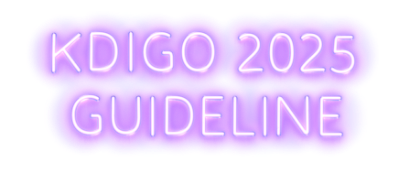*TARPEYO was studied under the name Nefecon, which was used in the KDIGO 2025 guideline.†Mucosal B cells present in the ileum, including the Peyer’s patches, express glucocorticoid receptors, and are responsible for the production of Gd-IgA1 causing IgAN. Through their anti-inflammatory and immunosuppressive effects at the glucocorticoid receptor, corticosteroids can modulate B cell numbers and activity. It has not been established to what extent the efficacy of TARPEYO is mediated via local effects in the ileum vs systemic effects.1,3 ‡The MEST-C scoring system is based on the Oxford Classification of IgAN.
The KDIGO 2025 guideline suggests TARPEYO be considered in a majority of patients for treatment of IgAN2
FOR PATIENTS WITH IgAN WHO ARE AT RISK OF
PROGRESSIVE LOSS OF KIDNEY FUNCTION*
In all patients, these should be
considered simultaneously
Manage the IgAN-specific
drivers for nephron loss
Stop† synthesis of
pathogenic forms
of IgA and IgA-IC
formation
Stop† IgA/IgA-IC–
mediated kidney
injury
[Nefecon]
glucocorticoids#
Kidney Disease: Improving Global Outcomes (KDIGO) IgAN and IgAV Work Group. Kidney Int. 2025;108(4S):S1-S71 with permission.
*Defined as proteinuria ≥0.5 g/d while on or off treatment. †Other mentions of this treatment goal in the KDIGO 2025 guideline refer to this action as “prevent” or “reduce.” ‡TARPEYO was studied under the name Nefecon, which was used in the KDIGO 2025 guideline. §As there is some systemic absorption of budesonide, patients and healthcare providers should be aware of the possibility of some systemic glucocorticoid-related side effects with TARPEYO. These are usually mild to moderate and reversible upon treatment cessation. ¶The KDIGO 2025 guideline suggests treatment with a 9-month course of TARPEYO for patients who are at risk of progressive loss of kidney function with IgAN (2B). Strength of recommendation: level 2, suggested; certainty of evidence: B, moderate. #In settings where Nefecon is not available, the KDIGO 2025 guideline suggests that patients be treated with a reduced-dose systemic glucocorticoid regimen combined with antimicrobial prophylaxis against Pneumocystis jirovecii and antiviral prophylaxis in hepatitis B carriers, along with gastroprotection and bone protection according to national guidelines.
DEARA=dual endothelin angiotensin receptor antagonist; FDA=Food and Drug Administration; Gd-IgA1=galactose-deficient IgA1; IgA=immunoglobulin A; IgA-IC=IgA-containing immune complex; KDIGO=Kidney Disease: Improving Global Outcomes; MEST-C=mesangial and endocapillary hypercellularity, segmental sclerosis, interstitial fibrosis/tubularatrophy, and crescents; MMF=mycophenolate mofetil; RASi=renin-angiotensin system inhibitor; SGLT2=sodium-glucose cotransporter 2.
REFERENCES: 1. TARPEYO. Prescribing Information. Calliditas Therapeutics AB; June 2024. 2. Kidney Disease: Improving Global Outcomes (KDIGO). KDIGO 2025 clinical practice guideline for the management of immunoglobulin A nephropathy (IgAN) and immunoglobulin A vasculitis (IgAV). Kidney Int. 2025;108:S1-S71. 3. Lafayette R, Kristensen J, Stone A, et al. Efficacy and safety of a targeted-release formulation of budesonide in patients with primary IgA nephropathy (NefIgArd): 2-year results from a randomized phase 3 trial. Lancet. 2023. http://doi.org/10.1016/S0140-6736(23)01554-4









